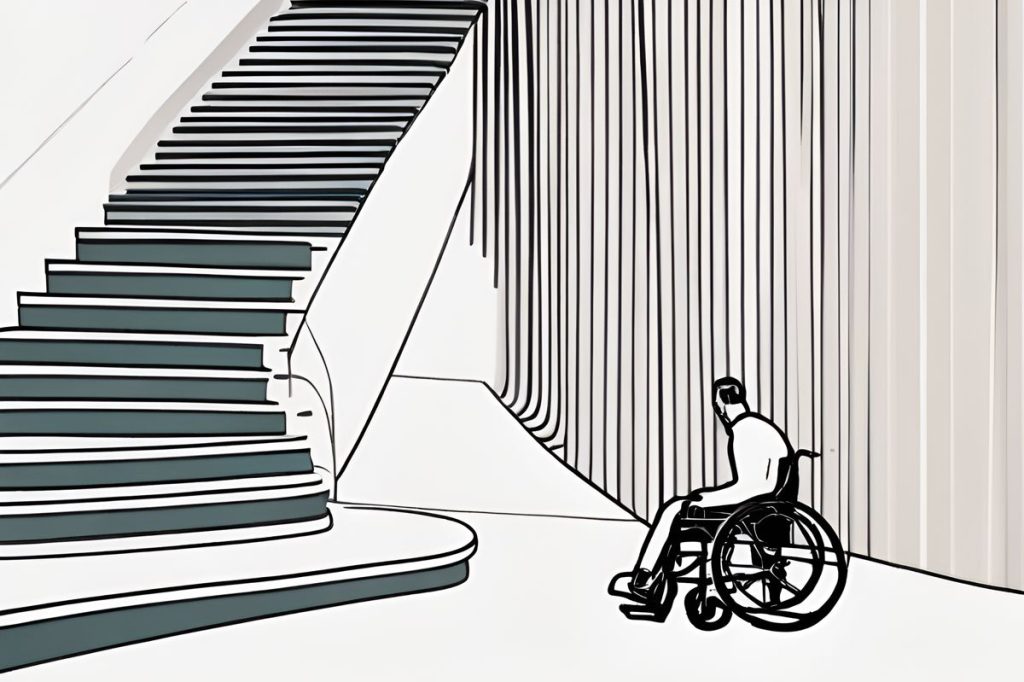Wheelchair users face significant barriers in public spaces, like the absence of ramps, leading to frustration and limited independence. Dimitris Lambrianides, of Opak, highlighted this issue when he had to yell from a window to gain access, showcasing the ongoing struggle for inclusive design and equal opportunity.
What are the main barriers wheelchair users face in public spaces?
Wheelchair users encounter significant barriers in public spaces, such as the absence of ramps or elevators, and inconsistent implementation of accessible design in buildings. These obstacles lead to frustration, diminished independence, and limited participation in daily activities, undermining the fundamental human right to accessibility.
A Call to Action for Inclusive Access
In a stirring outcry for change, Dimitris Lambrianides, the head of the disabilities association Opak, has publicly criticized the insufficient wheelchair access in public spaces. Recently, he was confronted by a stark reminder of this prevailing issue—steps at an entrance where a ramp should have been. On social media, Lambrianides recounted the indignity of having to attract attention from a back window and demand that a door be opened to accommodate his entry. “They had to open the back door after I yelled at them from the window – yes, from the window – because I could not go in,” he shared, reflecting a frustration known all too well by many individuals with mobility impairments.
This incident occurred at a school known to have rooms accessible without stairs, highlighting inconsistencies in the implementation of accessible design. The association’s outcry starkly contrasts with recent government assurances that disability access has been a prioritized effort. Such assurances fall flat, however, when individuals like Lambrianides face barriers in everyday life.
The Wider Impact of Inaccessibility
Accessibility is not just about convenience; it’s a fundamental human right. The United Nations Convention on the Rights of Persons with Disabilities (UNCRPD), which many countries have ratified, underscores the importance of personal mobility and the ability to access the physical environment. When institutions fail to provide adequate access, they not only infringe on these rights but also send a message of exclusion to the disability community.
The effects of inaccessibility extend beyond the immediate physical barriers. For individuals with disabilities, encountering such obstacles can lead to feelings of frustration, decreased independence, and reduced participation in social, educational, and professional activities. It’s not just about installing ramps or elevators; it’s about nurturing an inclusive society where every person is valued and given equal opportunity to contribute.
Towards an Inclusive Society
The situation Lambrianides faced is indicative of a larger systemic issue. While many buildings and public areas have made strides towards becoming more accessible, there’s still a long road ahead. It’s not uncommon for older buildings to lack proper adaptations, and even new constructions sometimes fail to meet accessibility standards due to oversight or neglect.
Creating a truly accessible environment requires a multifaceted approach. It calls for stringent adherence to building codes that prioritize accessibility, regular audits of public spaces, and a shift in societal attitudes to recognize and advocate for the rights of people with disabilities. It is imperative that governments, organizations, and individuals work collaboratively to dismantle the physical and attitudinal barriers that perpetuate exclusion.
The Role of Community and Government
Public outcry, like that from Lambrianides and Opak, is critical in pushing for change, but it’s only one piece of the puzzle. Real progress demands strong policies and effective enforcement. Communities must hold their leaders accountable, ensuring promises of accessibility are not just empty words but are followed by tangible action.
Moreover, education plays a pivotal role. By raising awareness about the challenges faced by individuals with disabilities and the benefits of inclusive design, communities can foster empathy and drive the demand for accessible spaces. When citizens understand the impact of their advocacy, they can become powerful allies in the fight for equal access.
While the road to universal accessibility is long, each step taken is a move towards a more inclusive society where everyone, regardless of their physical abilities, can participate fully and with dignity.
What are the main barriers wheelchair users face in public spaces?
Wheelchair users encounter significant barriers in public spaces, such as the absence of ramps or elevators, and inconsistent implementation of accessible design in buildings. These obstacles lead to frustration, diminished independence, and limited participation in daily activities, undermining the fundamental human right to accessibility.
Why is accessibility considered a fundamental human right?
Accessibility is not just about convenience; it’s a fundamental human right. The United Nations Convention on the Rights of Persons with Disabilities (UNCRPD) underscores the importance of personal mobility and the ability to access the physical environment. When institutions fail to provide adequate access, they not only infringe on these rights but also send a message of exclusion to the disability community.
What steps can be taken to create a more inclusive society for individuals with disabilities?
Creating a truly accessible environment requires a multifaceted approach. It calls for stringent adherence to building codes that prioritize accessibility, regular audits of public spaces, and a shift in societal attitudes to recognize and advocate for the rights of people with disabilities. It is imperative that governments, organizations, and individuals work collaboratively to dismantle the physical and attitudinal barriers that perpetuate exclusion.
How can communities and governments work together to improve accessibility?
Public outcry, like that from advocates like Dimitris Lambrianides and Opak, is critical in pushing for change, but it’s only one piece of the puzzle. Real progress demands strong policies and effective enforcement. Communities must hold their leaders accountable, ensuring promises of accessibility are not just empty words but are followed by tangible action. Furthermore, education plays a pivotal role in raising awareness about the challenges faced by individuals with disabilities and advocating for inclusive design in public spaces.

